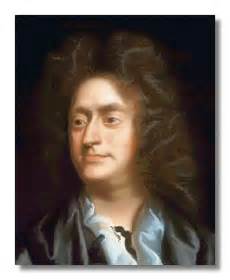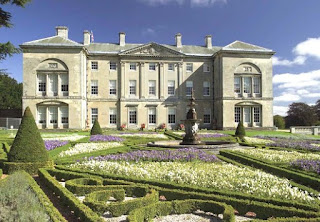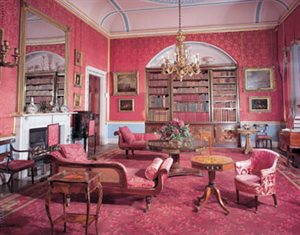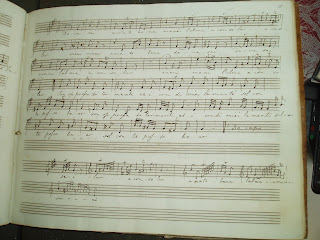Henry Purcell (10 September, 1659 – 21 November, 1695) is considered England’s greatest composer of the Baroque Era. Named one of the first British composers of significance, he was often called “Orpheus Britannicus”and his contribution to the musical heritage of his native land is immeasurable.
 |
| Henry Purcell |
Imagine then, the excitement stirred in the musical world in 1964, when Nigel Fortune, Purcell scholar, announced the discovery of a previously unknown ode by Purcell in a four-volume manuscript collection of the composer’s works at Tatton Park in Cheshire. ‘The Noise of Foreign Wars’ is preserved as a fragment in a bound collection first copied by Philip Hayes (1738-1797) Professor of Music at Oxford. After Hayes’s death, the collection was owned by Samuel Arnold (1740-1802) composer and conductor of the Academy of Ancient Music. In May of 1803, the collection was purchased by Mark Masterman Sykes of Sledmere in Yorkshire.
 |
| Sledmere House – Yorkshire |
How did it end up in the music room at Tatton Park? How did all of these men – a music professor, a composer and conductor, and a wealthy landowner in Yorkshire manage to save such a treasure so that Nigel Fortune might unearth it three hundred years after it was written? They didn’t. Well, they didn’t do it by themselves. It took….
A woman.
In the late seventeenth century, gentlemen of means began to collect books and art to display in their homes as a mark of their wealth and status. After all, no young man returned from his Grand Tour without some sort of souvenirs. (Preferably the sort for which one did not need to visit one’s physician.) Long galleries in which to display paintings and works of art and libraries became essential parts of the Society town-house and the country “ancestral pile”. Some homes were even designed or redesigned to feature these architectural aspects prominently.
In 1809, the biographer Thomas Frognall Dibdin called the obsessive collection of books by the nobility ‘bibliomania’. In 1812, an exclusive bibliophile society, the Roxburghe Club, was formed. One of its founding members? Mark Masterman Sykes. He was best known for his collection of books and engravings. By the end of 1810, his library at Sledmere was considered one of the finest in England.
And in 1807, Mark Masterman Sykes gifted his four-volume collection of Purcell’s music to his newly married sister, Elizabeth Sykes Egerton, of Tatton Park. (You thought I was never going to get there, didn’t you?)
Elizabeth Sykes was an accomplished musician at an early age. As a young girl, her music collection was like that of any musically inclined lady. Collections of the sort made by the accumulation of pieces with social occasions and entertainment in mind. Not to be taken seriously, or so the majority of Society (men) believed.
Her first music books are dated 1790 and are inscribed with her name – Miss Sykes. They consist of pre-ruled oblong copybooks into which she copied music from her piano lessons, folk songs, and catches. One book actually has two handwritings in it – one starts at one end of the book and the other starts at the other end. This was a common practice in copying music, especially when one wanted to divide the types of compositions – say sonatas at one end and hymns at the other. In some instances, a composition might be started, messed up and started over in a better fashion to the finish.
Her copybooks from 1799 and 1801 were larger pre-ruled music books from the London music publisher Robert Birchall. The covers were a bit more elegant with pages for her to inscribe her name and the details of the music in each one. There were vocal ornaments and notations in these in multiple hands. Even entire pieces appear to be copied by others. This can be attributed to the common practice of passing around these books to friends, the same way young ladies today might pass around CD’s or I-pods.
Elizabeth Sykes also purchased a great deal of printed sheet music. Fortunately for us, she signed all of her music as it was purchased. Therefore, it is easy to differentiate between the music she bought whilst unmarried, and those pieces she purchased after she married her cousin, Wilbraham Egerton, in 1806 and moved her collection to Tatton Park. (I know. She married her cousin, but he did play the cello.)
 |
| Tatton Park – Cheshire |
The collection of printed sheet music, because it was the realm of women, did not signify as collecting the way the accumulation of books and art did. However, these collections often contain copies of popular songs printed the night after their first performance at Vauxhall or at one of London’s theatres, never to be seen again. It is thought researchers have only begun to scratch the surface of many of these collections.
Elizabeth had a great deal of her music bound in indexed volumes. Her diligence and attention to her collection produced folio compilations as handsome as the albums of engravings and illustrated books on antiquities to be found in any bibliophile’s library. Her valuation of her music resulted in it being shelved and cared for the same way her husband’s and brother’s collections of books were.
 |
| Music room at Tatton Park |
As a result, in addition to the Purcell volumes gifted to Elizabeth by her brother, the music at Tatton Park includes rare numbers of Benjamin Goodison’s projected complete edition of Purcell begun in 1789. Nearly an entire shelf contains Samuel Arnold’s collection of Handel’s complete works. It is the first complete edition of any composer, pre-dating the Mozart Gesamtausgabe.
 |
||
| Dove sei by G.F. Handel (from the Samuel Arnold collection at Tatton Park) |
I have gone into great detail about the collection of music at Tatton Park and the incalculable debt we owe Elizabeth Sykes Egerton. Like those researchers who have renewed the world’s interest in these collections, I have only scratched the surface of this fascinating topic. There are impressive collections of music accumulated and preserved by Georgian and Regency women all over England. Lydia Hoare Acland’s collection at Killerton House in Devon. Mary Egerton Sykes music books at Sledmere in Yorkshire. Over two thousand items in Miss Cornewall’s collection at Mocca’s Court in Herefordshire.
The list goes on and musicologists are prowling the libraries and collections of stately homes all over England in search of the next great musical treasure. All tucked safely away by those accomplished young ladies, bluestocking women, and musical dragons who loved their music enough to preserve it for all of us.
I’ll be posting more on this subject in my next post. Not only more about the role women played in preserving England’s musical heritage, but also how their love of music changed the architectural design of many houses built during the late Georgian and Regency eras to accommodate that love.

Great.
This is fascinating, Louisa!
I'd love to hear more about the "popular" music of the time period, the music played at Vauxhall, for example. What would those young ladies be playing and singing with their friends?
Thank you, O Divine One! Actually some of the popular tunes they would have acquired as broad sheets from London – most printed the night after the song debuted at Vauxhall – would be quite bawdy, even by our standards. Young ladies were allowed a great deal more leverage when it came to their music. Because the key was to have new music out constantly, once the printers discovered what a lucrative business it was, many of the popular songs might be sung to old tunes. The words, however, could be about anything from the latest social scandal to the latest government debacle to the latest political upheaval. Then, of course, sex and romance were also popular topics. I will whip up a post here on the popular songs and their sources and post it here soon.
Thank you so much, Regine. I am so glad you enjoyed it.
Louisa, what a fascinating piece! And as Purcell is one of my favourite composers, I'm all in favour of finding more works (although given he only lived into his 30s (36?), he was enormously prolific with what we already know.
Thank you, La Divina! Purcell is one of my favorites as well. It breaks my heart all over again when I think of how young he was when he died. Heaven only knows what wondrous works we were deprived of by his death. And the sheer volume of his work for his years on this earth is astonishing!